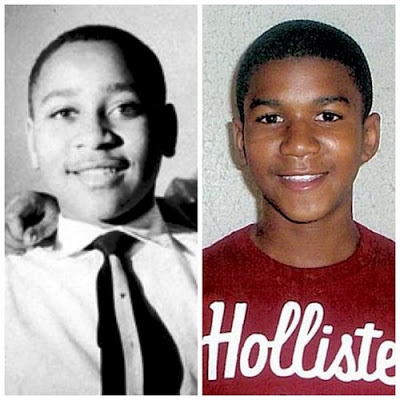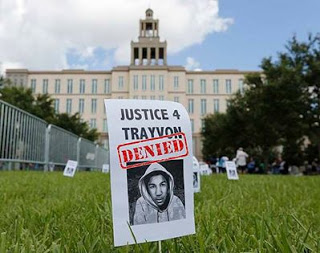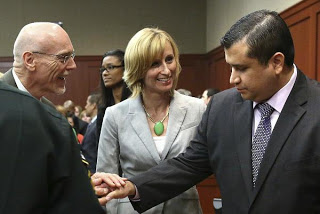 |
| Emmett Till, left, and Trayvon Martin. Image from Tumblr. |
Intimations of Emmett Till:
A ‘shocking story of
approved killing’ in Florida
Today the pre-1960s explicit racial ‘code’ has been supplanted by the implicit code upon which ‘profiling’ is based.
By Jay D. Jurie | The Rag Blog | July 18, 2013
The Rag Blog‘s Jay Jurie will discuss issues raised in this article with Rag Blog editor Thorne Dreyer on Rag Radio, Friday, July 26, 2013, from 2-3 p.m. (CDT) on KOOP 91.7-FM in Austin, and streamed live to the world. The show is rebroadcast by WFTE-FM in Mt. Cobb and Scranton, PA, Sunday mornings at 10 a.m. (EDT), and all podcasts are posted at the Internet Archive after broadcast.
SANFORD, Florida — Inevitable comparisons between Emmett Till and Trayvon Martin have been made by several observers, including Lecia Brooks of the Southern Poverty Law Center and Ben Jealous of the NAACP.
What happened to Emmett Till has been described in numerous accounts. By way of brief recap: In 1955 Till, a 14-year-old African-American from Chicago, was sent by his mother to stay with relatives in rural Money, Mississippi. That August, he entered a “mom and pop” grocery store where an encounter ensued between him and the proprietor, a young white woman named Carolyn Bryant.
What happened isn’t exactly clear. Till supposedly whistled at, or flirted with, the woman. While whatever he said or did may have been inappropriate, only in the South at that time would it have warranted a death sentence. Elsewhere, it would at most have been seen as a minor offense.
Even in 1950s racially-segregated Mississippi, Till had every legal right to be where he was. However, he overstepped the bounds of the “code” of subservient behavior imposed by the white majority on Southern African-Americans at that time. Although his relatives reportedly schooled him on the code, perhaps fueled by the impudence characteristic of teen-aged boys of any race, Till may have had little or no idea of the gravity of his “offense.”
Word of what occurred soon reached the husband of the store owner, Roy Bryant, and several nights later, with his half-brother, J.W. Milam, and possibly another companion, he kidnapped Till from the home of his great-uncle. Till was savagely beaten and tortured, and then shot. A 70-pound cotton mill fan was tied to his neck with barbed wire, and his body was dropped into the nearby Tallahatchie River.
Several days later, his body was discovered in the river and then was shipped back to Chicago. His mother ordered it placed in an open casket, so the extent of Till’s injuries could be seen. This created a sensation, with thousands viewing the body and the story receiving nationwide media coverage.
Seated in the racially-segregated courtroom at the subsequent trial of Bryant and Milam was an all-white jury selected from a part of the county known to be disposed against African-Americans. Not surprisingly, Bryant and Milam were acquitted. Protected against double jeopardy, Milam later admitted in a magazine interview they had in fact murdered Till.
The interview, by journalist William Bradford Huie, was published in Look magazine under the title, “The Shocking Story of Approved Killing in Mississippi” :
As long as I live and can do anything about it, niggers are gonna stay in their place. Niggers ain’t gonna vote where I live. If they did, they’d control the government. They ain’t gonna go to school with my kids. And when a nigger gets close to mentioning sex with a white woman, he’s tired o’ livin’. I’m likely to kill him. Me and my folks fought for this country, and we got some rights.
I stood there in that shed and listened to that nigger throw that poison at me, and I just made up my mind. “Chicago boy,” I said, “I’m tired of ’em sending your kind down here to stir up trouble. Goddam you, I’m going to make an example of you — just so everybody can know how me and my folks stand.”
Milam’s revelation sent shock waves across much of the country, and in its wake, the first of the major post-Reconstruction federal laws, the Civil Rights Act of 1957, was passed to secure the rights of African-Americans. It’s now widely contended the South is a far different place than it was prior to the Civil Rights Movement of the 1960s. Florida, some have argued, was always a much different place than Mississippi. However, that’s not entirely accurate, either then or now.
It can be argued that’s particularly not the case when it comes to Sanford, Florida, where 17-year old African-American Trayvon Martin was shot dead by Neighborhood Watch coordinator George Zimmerman on February 26, 2012. Sanford was historically an agricultural community with an African-American population employed as farm labor. When the agriculture industry declined, this population was left stranded economically.
 |
| One more time. Image from Tumbler. |
A very recent movie, 42, about Jackie Robinson, the first African-American major league baseball player, features scenes from Sanford in the late 1940s. One scene, of Robinson being thrown off a playing field by the police chief, is represented as taking place in nearby Deland, when it actually occurred in Sanford. Another scene, showing Robinson being forced to flee Sanford due to threatened Ku Klux Klan violence, is accurate (Goldsboro Historical Museum).
Sanford is where fatally-injured civil rights pioneers Harry T. and Harriette V. Moore were taken after their nearby home was bombed by the Klan in 1951. Sanford filled in its downtown public swimming pool rather than allow it to be integrated, and to this day, the only public swimming pool is in a predominantly African-American part of town.
Like the rest of Florida, and the South, Sanford has experienced change. However, not only is the past still present, but ongoing efforts preserve the status quo ante. While Sanford possesses several diverse neighborhoods, most of the town remains divided into sectors which are either predominantly white or predominantly African-American. Sanford has been the scene of several instances of police abuse or neglect of the African-American population, which have lately been extensively covered in the mass media.
Explicit, hard-core racism, as epitomized by the Milam quote above, is largely part of the past. Nonetheless, even more insidious, and more intractable, is implicit, soft-core racism. Illustrating this is the debate in 1998 to build a hotel-conference center in the same downtown park as the filled-in swimming pool.
Testimony from white residents in support of this proposal was based on the claim that the park was only used by drug-dealers, pimps, and prostitutes. Yet, no evidence was ever produced in support of this assertion, whereas many of the park users consisted of African-American boys and young men playing basketball.
Although not overtly stated that way, this was a not-so-transparent means for whites to reclaim “their” park. Similarly, until met with considerable protest, a recent city ordinance prohibited fishing along portions of the city’s river front, when clearly the large majority of the people who fished there were African-American.
A prominent white citizen, while campaigning for city council, proposed running the homeless out of downtown, and building a shelter on 13th Street, which is the heart of Goldsboro, the most prominent African-American neighborhood in Sanford. This proposal did not meet with success, but instead, Sanford’s imposing new police center was put in the heart of the community.
Incidentally, Goldsboro was once a separate and distinct African-American municipality, which over the objections of its residents, was incorporated into Sanford.
Trayvon Martin was murdered at the Retreat at Twin Lakes subdivision, in a rapidly developing part of Sanford, a somewhat diverse part of town alongside Interstate 4 also featuring other newer housing developments, big box stores, strip malls, including the 7-11 where he bought his last Skittles and iced tea, and auto dealerships. Not far to the east is Goldsboro, placing the newer and unstable identity of the Retreat in proximity to “old” Sanford.
It was into this admixture of past and present that George Zimmerman stepped in his self-appointed role as Neighborhood Watch captain. Speculatively, Zimmerman may be uncertain about, or conflicted with, his own ethnic identity. Of Jewish and Hispanic background, it is unlikely the explicitly racist white supremacists would consider him one of their own.
In addition to being a “wannabe cop,” Zimmerman may also have been asserting his desire for acceptance by “white culture,” he may have sought to protect both this identity, and community, which may have helped frame and foster implicit racist presumptions.
Today the pre-1960s explicit racial “code” has been supplanted by the implicit code upon which “profiling” is based. When Trayvon Martin sought to return to where he was staying with his father, even less knowingly than Emmett Till he violated that code. In today’s “New South,” perhaps especially in “purple” Florida, he may have thought he was more free than he was, not understanding he did not “belong” in that neighborhood, and was expected to react obsequiously if confronted by a “creepy-ass cracker.”
 |
| Validation: George Zimmerman congratulated by attorneys Don West and Lorna Truitt after verdict. Photo by Joe Burbank / Reuters. |
Implicit racism should be regarded as part of an entrenched system of values. Like its unwritten code, this system sustains itself through the denial of its existence. Granting a defense motion in the Zimmerman case, Judge Debra Nelson ruled the prosecution could not use the word “race” in describing “profiling.” In a CNN interview with Anderson Cooper after the trial, “Juror A-37” claimed “we didn’t talk about race” during the jury deliberations.
While the jury at the Emmett Till trial, was all white, the jury in the Zimmerman case, with one Hispanic exception, was all white. An interesting question, which the prosecution apparently was not allowed to ask during voir dire, even if they wanted to, was the extent to which prospective jurors might identify with “white culture and values,” or to what extent they were familiar with, or subscribed to, the “code.”
Seminole County, the pool from which the jury pool was drawn, is 81% white, including 65% non-Hispanic white, and 12% African-American (U.S. Census).
A closely-related question not considered is Seminole County’s political climate. Whereas in 2012 Barack Obama won Florida, Mitt Romney won Seminole County 53% against 46% for Obama (Politico.com). Aside from Democratic pockets of the County consisting largely of African-American and Hispanic voters, and a scattering of white liberals, the white population is fairly solidly conservative.
A jury drawn from this political background is more likely to identify with the narrative spun by George Zimmerman, and be unaware of the influence of the “code” or even deny its existence.
Some argue the problem today is no longer race, but gun laws such as “stand your ground” that must be changed. There can be little doubt that such laws cry out desperately for change. But, especially here, the race factor is inescapable.
Critics contend Zimmerman was tried on the grounds of self-defense, not stand your ground. Regardless, it was Zimmerman’s stand your ground claim that allowed him to walk free for a month and a half before public pressure resulted in his arrest.
Evidence at trial indicated Sanford Police believed and supported Zimmerman’s claim, which implicitly denied Trayvon Martin’s legitimate right to be where he was, and dismissed the possibility that an unarmed Martin unsuccessfully attempted to stand his own ground.
Preliminary research has found that stand your ground laws are predominantly biased in favor of whites at the expense of African-Americans (Richard Florida, The Atlantic Cities).
There’s the current case of Marissa Anderson, a black woman in Florida who produced no injury when she fired a warning shot at her abusive husband, but when she claimed a stand your ground defense, received a 20-year prison sentence on a charge brought by Angela Corey, the same state attorney who unsuccessfully prosecuted George Zimmerman.
What happened to Trayvon Martin is not simply an anomaly. Some racial progress has been made. Sanford, Florida, in 2013 is not Money, Mississippi in 1955. But we are not as far removed from that time or place as many would misleadingly have us believe. We need look no further than the approved killing of Trayvon Martin.
[Jay D. Jurie, Ph.D., is an associate professor of public administration and urban and regional planning at the University of Central Florida. He lives in Sanford, Florida. Read articles by Jay D. Jurie on The Rag Blog.]
Also see “Walking while black: Trayvon Martin’s fatal shortcut” by Jay D. Jurie on The Rag Blog, March 22, 2012.
Citations and References:
Richard Florida, The Atlantic Cities article: http://www.theatlanticcities.com/politics/2013/07/its-not-just-zimmerman-race-matters-lot-stand-your-ground-verdicts/6195/
Goldsboro Historic Museum, Sanford, on Facebook: https://www.facebook.com/Foliver1961
Huie, William Bradford, PBS: http://www.pbs.org/wgbh/amex/till/sfeature/sf_look_confession.html
Robin D.G. Kelley article on systematic racism: http://www.counterpunch.org/2013/07/15/the-us-v-trayvon-martin/
Sanford, FL: a place to wait for a verdict: http://tv.msnbc.com/2013/07/12/in-black-sanford-a-place-to-gather-and-wait-for-a-verdict-2/
SPLC compares Emmett Till and Trayvon Martin: http://www.splcenter.org/get-informed/news/statement-from-civil-rights-memorial-center-director-lecia-brooks-in-response-to-v
Washington Post article on the Zimmerman trial verdict and justice: http://www.washingtonpost.com/opinions/ruth-marcus-zimmerman-verdict-in-martin-case-shows-justices-flaws/2013/07/14/7f7eae6a-ecc7-11e2-a1f9-ea873b7e0424_story.html


















Regarding Zimmerman’s religious/ethnic and U.S. military family background, according to the April 25, 2012 Reuters profile of him:
“George Michael Zimmerman was born in 1983 to Robert and Gladys Zimmerman, the third of four children. Robert Zimmerman Sr. was a U.S. Army veteran who served in Vietnam in 1970, and was stationed at Fort Myer in Arlington, Virginia, in 1975 with Gladys Mesa’s brother George. Zimmerman Sr. also served two tours in Korea, and spent the final 10 years of his 22-year military career in the Pentagon, working for the Department of Defense, a family member said.
“In his final years in Virginia before retiring to Florida, Robert Zimmerman served as a magistrate in Fairfax County’s 19th Judicial District.
“Robert and Gladys met in January 1975, when George Mesa brought along his army buddy to his sister’s birthday party. She was visiting from Peru, on vacation from her job there as a physical education teacher. Robert was a Baptist, Gladys was Catholic. They soon married, in a Catholic ceremony in Alexandria, and moved to nearby Manassas.
“Gladys came to lead a small but growing Catholic Hispanic enclave within the All Saints Catholic Church parish in the late 1970s, where she was involved in the church’s outreach programs…. Zimmerman served as an altar boy at All Saints from age 7 to 17, church members said.
“He wasn’t the type where, you know, ‘I’m being forced to do this,’ and a dragging-his-feet Catholic,” said Sandra Vega, who went to high school with George and his siblings. “He was an altar boy for years, and then worked in the rectory too…. At 14 he became obsessed with becoming a Marine, a relative said, joining the after-school ROTC program at Grace E. Metz Middle School and polishing his boots by night….”
Justice was served. It felt great to see all the race baiting (that certainly includes the author of this ridiculous article), and “stand-your-ground-needs-to-go” talking heads get served up a face full of facts.
Where I live, (or lived before I sold) most of the neighbors knew each others vehicles, schedules, and family members. It was not unusual to take a little walk around the block if there were strange cars parked in a neighbors driveway, or people that we didn’t know walking around looking at homes.
Zimmerman didn’t do anything different than my neighbors did for me and I did for them. And if Martin had thrown a punch and tackled and then went for the concealed carry gun of one of the men in my neighborhood who happened to be keeping an eye on him as he was walking through our neighborhood, he would be just as dead. I repeat. Justice was served and its good to see the race baiters (that’s you Jay) have to scream even louder to convince the public it was a racial event.
– Extremist2TheDHS
President Obama, apparently with his professorial hat back in place, mused recently that “Trayvon could have been me”. To which I must reply, if only we could be so lucky.
– Extremist2TheDHS